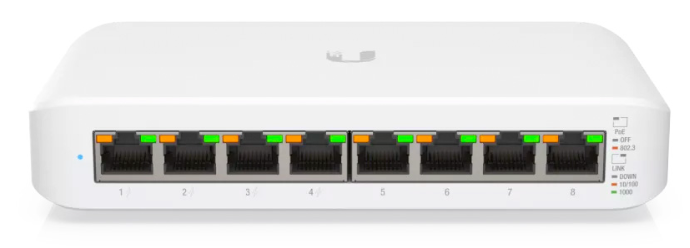IEEE 802.3 Active Power over Ethernet Standards
There are several standards for Active/ Standard POE, which specify the maximum amount of power that can be delivered over Ethernet cables.
Here is a list of some popular PoE midspan and endspan devices for your consideration.
 Unifi Active PoE Switch
Unifi Active PoE SwitchHere are the four main POE standards:
1. IEEE 802.3af (PoE):
- Power Delivery: Up to 15.4W of DC power per port (min of 12.95W guaranteed at the powered device).
- Supply voltage of 44-57V DC, current, 0.1-0.35A
- Pin Configuration: Mode A or Mode B.
- Powering Options: Delivers power over the same pairs used for data transmission (pins 1, 2, 3, and 6 in Mode A or pins 4, 5, 7, and 8 in Mode B).
- Ethernet Cable: Utilizes Category 3 or higher-grade cables (e.g., Cat 5, Cat 5e, or Cat 6) for power and data transmission.
- Typical Use Cases: IP phones, wireless access points, and low-power network devices.
2. IEEE 802.3at (PoE+):
- Power Delivery: Up to 30W of DC power per port (min of 25W guaranteed at the powered device).
- Supply voltage of 50-57V DC, current 0.01-0.6A
- Pin Configuration: Mode A or Mode B.
- Powering Options: Supports both Mode A and Mode B power delivery.
- Ethernet Cable: Utilizes Category 5e or higher-grade cables (e.g., Cat 6 or Cat 6a) for power and data transmission.
- Typical Use Cases: High-power wireless access points, pan-tilt-zoom (PTZ) IP cameras, LCD displays, biometric sensors and advanced network devices requiring higher power levels.
PoE+ (IEEE 802.3at) is backwards compatible with POE (IEEE 802.3af) meaning it will power even legacy POE power devices.
- Power Delivery - Provides two power levels:
- Type 3: Up to 60W of DC power per port (min of 51W guaranteed at the powered device).
- Type 4: Up to 100W of DC power per port (min of 71W guaranteed at the powered device).
- Pin Configuration: Mode A or Mode B.
- Powering Options: Supports both Mode A and Mode B power delivery.
- Ethernet Cable: Utilizes Category 5e or higher-grade cables (e.g., Cat 6 or Cat 6a) for power and data transmission.
- Typical Use Cases: High-power devices such as video conferencing systems, lighting systems, and industrial applications.
(IEEE 802.3bt) is backwards compatible with both IEEE 802.3af and IEEE 802.3at meaning it will power even legacy POE power devices.4. UPoE (Cisco Ultra-PoE):This is a proprietary standard developed by Cisco that provides up to 60 watts of power per port. It is similar to IEEE 802.3bt, but it uses a different power management system.

Note that the power sourcing equipment (PSE), such as a PoE-enabled switch or injector, must comply with the corresponding PoE standard to ensure compatibility with powered devices (PDs). Additionally, PDs must also adhere to the specific PoE standard requirements to receive power safely and efficiently over Ethernet cables.
Table of Comparison:
Type | Standard | PD Min. Power Per Port | PSE Max. Power Per Port | Cable Category | Power Over Pairs | Voltage at PSE (VDC) | Voltage at PD (VDC) | Maximum Current in (A) per pair |
Type 1 | IEEE 802.3af | 12.95W | 15.4W | Cat3/5 | 2 pairs | 44 - 57 | 37 -57 | 0.35 |
Type 2 | IEEE 802.3at | 25W | 30W | Cat5 | 2 pairs | 50 - 57 | 42 - 57 | 0.6 |
Type 3 | IEEE 802.3bt | 51W | 60W | Cat5/6 | 2 pairs class 0-4, 4 pairs class 5-6 | 50 - 57 | 42 - 57 | 0.6 |
Type 4 | IEEE 802.3bt | 71W | 100W | Cat5/6/7 | 4 pairs class 7-8 | 52 - 57 | 41 - 57 | 1.0 |
These standards allow network administrators to power a wide range of devices through Ethernet cables, reducing the need for separate power supplies and making network deployments more flexible and efficient.
Related Articles
Power over Ethernet (PoE) Basics - Active POE
Power over Ethernet (PoE) is a technology initially introduced by Cisco in the early 2000s. It enables the transmission of electrical power alongside data signals over standard Ethernet cables. It allows network devices, such as IP phones, wireless ...Dusk to Dawn Streetlight Power for Outdoor Decorative Lights
Outdoor decorative/ holiday lights have the ability to convert regular spaces into warm, safe and inviting landscapes; consistently serving as sources of beauty and inspiration within communities during the festive season. It is true that most, if ...Frequently Asked Questions: Streetlight Power Tap Adapters
A streetlight power tap adapter is a device that allows you to tap into the power supply of a streetlight. It installs between the ANSI C136.10 receptacle on top of the luminaire and the photocell without interfering with normal photocontrol ...Samlex SEC-1212P Desktop Switching Power Supply for the Motorola APX 8500 Radio
In the world of radio communications, a dependable power source is just as important as a high-performance radio. This is where the Samlex SEC-1212P Desktop Switching Power Supply comes into play for Motorola APX 8500 radio users. The APX 8500 High ...Power Termination Options for Photocell Adapters
Power Termination Options for Photocell Adapters Rfwel Engineering offers streetlight power taps meeting diverse customer requirements. By tapping the AC voltage supplied to the streetlight luminaires, photocell power taps provide a cost-effective ...